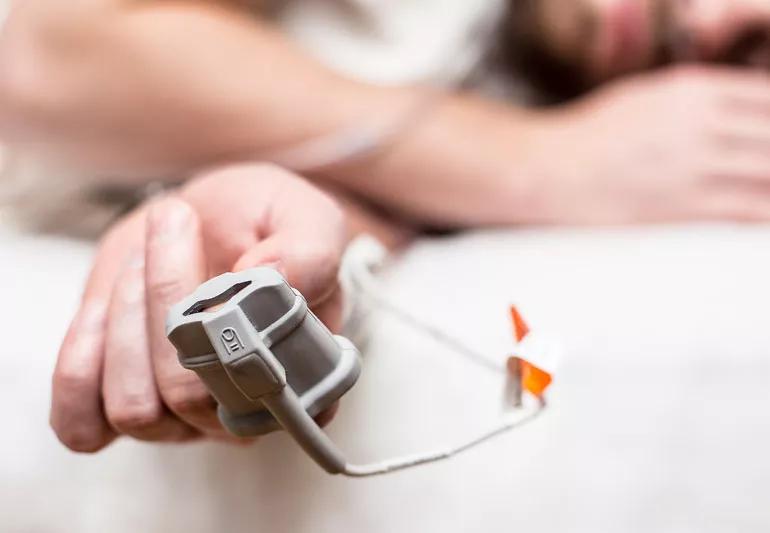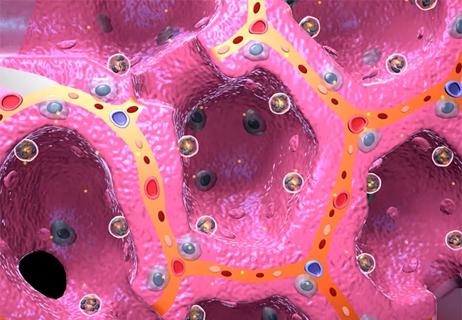Findings show profound muscle loss variance between men and women

Even though many COPD patients experience low oxygen levels at night, isolated nocturnal hypoxemia is a symptom that it not typically treated. Now, a new study by Cleveland Clinic researchers finds that it may be a cause of sarcopenia - the muscle-wasting condition that often affects these patients.
Advertisement
Cleveland Clinic is a non-profit academic medical center. Advertising on our site helps support our mission. We do not endorse non-Cleveland Clinic products or services. Policy
The researchers found that COPD patients with low nighttime oxygen levels had reduced muscle mass and also performed poorer on exercise tests. Notably, they also found that men were more severely affected than women.
“This may be a cause for sarcopenia in COPD patients,” says first author Amy Attaway, MD, a pulmonologist at Cleveland Clinic. “We should think about it, screen for it and consider treating it in our patients.”
Sarcopenia is common in COPD patients and can have a significant impact on their quality of life by limiting their ability to exercise and engage in everyday activities. It’s also associated with increased hospitalization, more frequent COPD exacerbations, and mortality.
It’s often missed because patients may assume that their growing weakness is due to their lung disease, rather than muscle loss. Clinicians have difficulty treating it because they don’t always understand its cause.
Previous studies have found a connection between mortality and daytime hypoxemia, Dr. Attaway explains, and patients with low oxygen levels during the day may be prescribed supplemental oxygen.
“It’s something we’ve been screening for,” she says. “But we haven’t been thinking about what’s happening when COPD patients are sleeping.”
In the new study, researchers analyzed data from a large sleep registry at the Cleveland Clinic. Patients with obstructive sleep apnea were excluded so that researchers could focus specifically on the effects of COPD-related nocturnal hypoxemia.
Researchers used the patients’ CT scans to measure pectoral muscle mass and looked to see if the patients had undergone a sleep study within one year. They considered five parameters for quantifying nocturnal hypoxemia and compared results for men and women.
Advertisement
“We were surprised and excited by the fact that in almost every way we measured nocturnal hypoxemia, it seemed to be associated with muscle loss,” says Dr. Attaway.
She says the sex differences were another surprise. Men were more likely to experience muscle loss at a higher threshold of oxygen saturation than women.
“It seemed that men were more affected than women, but we don’t fully understand why yet,” Dr. Attaway says.
She notes the study points to the importance of looking beyond lung function in treating COPD.
“Nocturnal hypoxemia may not be affecting mortality right away, but it could still be affecting the patient’s organs or muscles,” she explains. “We should also be thinking more about how COPD affects the rest of the body and how we can treat that too.”
The researchers plan to follow up with a prospective study to validate their findings and to learn more about how hypoxemia causes muscle loss and potential treatments.
Their paper, “Nocturnal Hypoxemia is Associated with Sarcopenia in COPD Patients,” was published earlier this year in Annals of the American Thoracic Society.
Advertisement
Advertisement

New breakthroughs are shaping the future of COPD management and offering hope for challenging cases

Case study illustrates the potential of a dual-subspecialist approach

Advanced COPD care benefits from a variety of perspectives

As genetic insights refine diagnosis, research abounds on current and emerging therapies

Advances in imaging technology could offer new insights for combatting age-related muscle loss

Genetic testing at Cleveland Clinic provided patient with an updated diagnosis

New tools and protocols to improve care

Endoscopic balloon dilation during pregnancy helps optimize outcomes